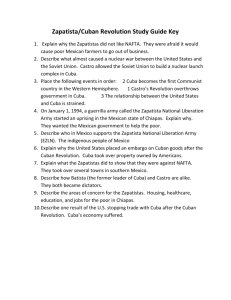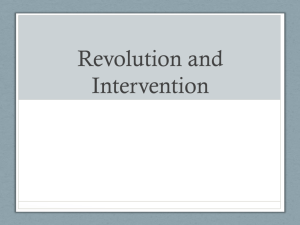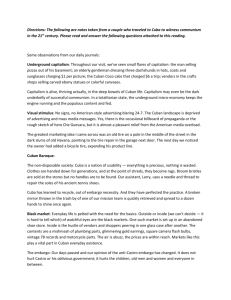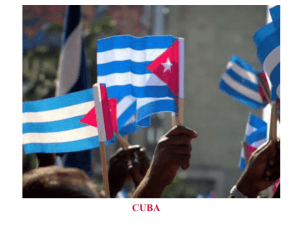LatAm.12.cuba - High Point University
advertisement
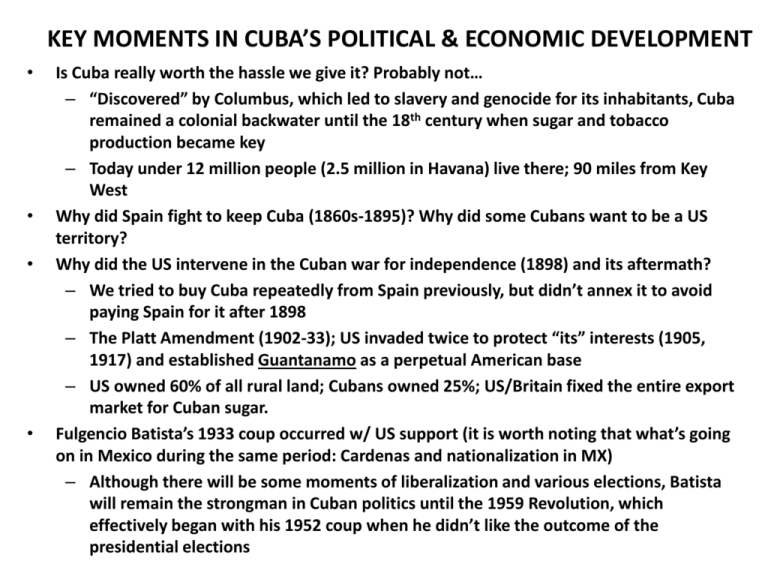
KEY MOMENTS IN CUBA’S POLITICAL & ECONOMIC DEVELOPMENT • • • • Is Cuba really worth the hassle we give it? Probably not… – “Discovered” by Columbus, which led to slavery and genocide for its inhabitants, Cuba remained a colonial backwater until the 18th century when sugar and tobacco production became key – Today under 12 million people (2.5 million in Havana) live there; 90 miles from Key West Why did Spain fight to keep Cuba (1860s-1895)? Why did some Cubans want to be a US territory? Why did the US intervene in the Cuban war for independence (1898) and its aftermath? – We tried to buy Cuba repeatedly from Spain previously, but didn’t annex it to avoid paying Spain for it after 1898 – The Platt Amendment (1902-33); US invaded twice to protect “its” interests (1905, 1917) and established Guantanamo as a perpetual American base – US owned 60% of all rural land; Cubans owned 25%; US/Britain fixed the entire export market for Cuban sugar. Fulgencio Batista’s 1933 coup occurred w/ US support (it is worth noting that what’s going on in Mexico during the same period: Cardenas and nationalization in MX) – Although there will be some moments of liberalization and various elections, Batista will remain the strongman in Cuban politics until the 1959 Revolution, which effectively began with his 1952 coup when he didn’t like the outcome of the presidential elections HOW DID THE REVOLUTION (1959) CHANGE CUBA? • Why did Castro’s 26th Of July Movement succeed (1953 try failed)? Largely because the old regime was tired and weak, but also because the US pressured the Batista regime • Why wasn’t this your typical bloody revolution? • Why did the Cuban revolution turn to Russian-style socialism (not communism) and a “command economy” (vs. state capitalism)? The US and especially exiles in Miami played a key role • Why did Cuba become an aggressive exporter of revolution (What is “off shore balancing,” and why did we take the War on Terror to the Middle East)? • What positive reforms took place? Land redistribution, mass education for all, universal health care, women’s rights, racial discrimination outlawed • Any downsides? Religious persecution, severe political repression. There was no legal opposition allowed… Why did Cuba prevent people from leaving after the 1960s? HOW HAS THE US RELATIONSHIP TO CUBA SHAPE THE ISLAND’S POLITICS AND ECONOMY? • • • • Closer ties with the USSR and seizure of US firms (1960) Start of the US trade embargo (1960/62) The Bay of Pigs (1961) & the Missile Crisis (1962) Automatic US asylum (1965); only recently changed to “dry foot” policy • Recent events: The Mariel boatlift (1980), the Rectification Campaign (1986-90), USSR Collapse (1991), the 2nd boatlift (1994) • 2009: Castro gives over day to day power to his brother Raul, and Cuba may be beginning a transition… US responded by loosening remittance policies and allowing more travel. • 2015: Full thaw underway. US behavior is very important now, so events are probably good news. HOW IS POWER ORGANIZED IN CUBA? (WE WON’T GO OVER THIS IN GREAT DETAIL, BUT BE FAMILIAR WITH THE ORGANIZATION OF STATE POWER) • • • • The 1976 Constitution: mandates socialism, it requires all social groups have approval, and limits speech and press. The big picture: Like most communist systems, the political system in Cuba has two parallel sets of political structures—the communist party and the actual government. At every level there is considerable overlap in membership. Thus, Fidel Castro was both the president of the government’s Council of Ministers and the PCC’s secretary, while his brother Raul was the second in command for both institutions. Like all Soviet-model systems, power is set up so that the Cuban Communist Party, the PCC (the secretary, the Politburo, the Central Committee, and the Party Congress) makes all of the important decisions. The implementation of decisions—the executive branch—is overseen by the Council of Ministers, the Council of State, and the National Assembly The party: The Cuban Communist Party is the only legal party; about 5% of Cubans belong. The Party Congress—formally the most important political institution in Cuba—only meets every five years to approve a macro- plan and select the 150-member Central Committee. This committee meets very frequently, but leaves day to day decisions to the Politburo, which it selects according to the whims of the Castro brothers. HOW IS STATE POWER ORGANIZED IN CUBA? • The legislature (very weak): The National Assembly has 609 members who are elected for five year terms, in uncontested elections in a district system that doesn’t (formally) allow party nomination or campaigns. A party institution puts together the final list. • At least in theory, the National Assembly elects the Council of State and approve that council’s selection of the Council of Ministers and the President, but like China or the Soviet Union, these elections are top-down decisions rather than bottom-up like a real democracy. • Federalism?: Cuba’s 169 municipal governments have limited power, but serve as the main connection between the government and everyday people. The terms for local officials are 2.5 years and elections have only party-vetted candidates. There are no campaigns or press, but the people have choices among candidates. • Of course, the CPP also has a sub-national presence; “Committees for the Defense of the Revolution” (one for every 100 Cubans); they both inform and monitor at the neighborhood level. WHY WOULD ANY COUNTRY WANT TO BE LIKE CUBA? (MANY DO) Is this a viable path to development? • What can Cuba tell us about the revolutionary path to development and socialism? Is it an example worth repeating? • Is it really possible to replicate the Cuba experience? (Cold War context, island status) • What kind of human rights matter (negative vs. positive rights)? Is there something to the Cuban argument about which should be the priority? • What will Cuba be like without the US embargo? Without Castro? (Harnecker) – Politically, the current plan is for China or Mexican style one party, technocrat rule where power shifts from a leader or two to the party in what will be bureaucratic authoritarianism with a rotating oligarchy. Economic school 1: Perfect state socialism (think China under Mao) – Economic school 2: Market socialism (probably thinking about modeling Sweden, but with the politics you’d end up with China under Deng) – Economic school 3: “the self-managementists” think Cuba can build on moral capitalism & social equality of last 50 years to micro-democratize to the community level to become truly what Marx had in mind with communism

